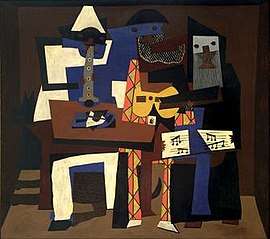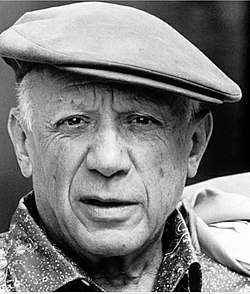Three Musicians
Three Musicians is the title of two similar collage and oil paintings by Spanish artist Pablo Picasso. They were both completed in 1921 in Fontainebleau near Paris, France, and exemplify the Synthetic Cubist style; the flat planes of color and "intricate puzzle-like composition" echoing the arrangements of cutout paper with which the style originated. These paintings each colorfully represent three musicians wearing masks in the tradition of the popular Italian theater Commedia dell'arte.[1]

%2C_oil_on_canvas%2C_204.5_x_188.3_cm%2C_Philadelphia_Museum_of_Art.jpg)
Each painting features a Harlequin, a Pierrot, and a monk, who are generally believed to represent Picasso, Guillaume Apollinaire, and Max Jacob, respectively.[2][1] Apollinaire and Jacob, both poets, had been close friends of Picasso during the 1910s. However, Apollinaire died of the Spanish flu in 1918, while Jacob decided to enter a monastery in 1921.[3]
One version is in the permanent collection of the Museum of Modern Art (MoMA) in New York City;[2] the other version is in the Philadelphia Museum of Art.[1]
See also
Notes
- "Collections Object: Three Musicians Pablo Ruiz y Picasso, Spanish, 1881 - 1973". Philadelphia Museum of Art. Retrieved 16 August 2017.
- "Pablo Picasso. Three Musicians. Fontainebleau, summer 1921". Museum of Modern Art. Retrieved 16 August 2017.
- "Picasso, Pablo". Oxford Art Online.

